Rangemaster Classic Deluxe 90 User Manual

Classic Deluxe 90
Dual Fuel
Users Guide
&
Installation & Service Instructions
U109300 - 01
Be safe
Warning
Accessible parts will become hot in use. To avoid burns and scalds children should be kept away
You need clean fresh air - so does your cooker. Burner flames produce exhaust gases, heat and moisture. Make sure that the kitchen is well ventilated: keep natural ventilation holes open or install a powered cooker hood that vents outside. If you have several burners on or use the cooker for a long time, open a window or turn on an extractor fan. For more detail see the Installation Instructions.
Care should be taken that no water seeps into the appliance.
During use, and afterwards, the appliance will be warm, so be careful with little children. If the younger members of your family are allowed into the kitchen we strongly advise that they are kept under supervision at all times.
We recommend you read ‘General Safety Instructions‘ (especially if you have not used a dual fuel cooker before) where we describe some basic guidelines on how to use your cooker safely.
Gas and Electricity on
Make sure that the gas supply is turned on and that the cooker is wired in and switched on. The cooker needs electricity.
Peculiar smells
When you first use your cooker it may give o a slight odour. This should stop after a little use.
Before using for the first time, make sure that all packing materials have been removed and then to dispel manufacturing odours, turn the ovens to 230°C and run for an hour.
Make sure the room is well ventilated to the outside air, by opening windows or turning on a cooker hood for example. We recommend that people with respiratory or allergy problems should vacate the area for this brief period.
Before using the grill for the first time you should also turn on the grill and run for 30 minutes with the grill pan in position, pushed fully back, and the grill door open.
Installation
In the UK the cooker must be installed by a CORGI registered engineer. Failure to install the appliance correctly could invalidate any warranty or liability claims and lead to prosecution. This appliance shall be installed in accordance with the regulations in force and only in a well ventilated space. Read the instructions before installing or using this appliance.
This appliance should not be installed in a boat or caravan.
2

Contents
Hotplate Burners |
Page 4 |
The Wok cradle |
Page 5 |
|
|
The Ceramic hob / Griddle |
Page 6 |
|
|
The Grill |
Page 8 |
|
|
The Ovens |
Page 9 |
|
|
The Clock |
Page 10 |
|
|
Cooking using the timer |
Page 11 |
|
|
Multi-function oven functions |
Page 12 |
|
|
Oven shelves |
Page 14 |
|
|
The Handyrack |
Page 14 |
|
|
Oven light |
Page 15 |
|
|
Storage |
Page 15 |
|
|
Multi-function Oven cooking guide |
Page 16 |
|
|
Oven Cooking chart - Conventional and full Fan oven functions |
Page 17 |
|
|
Cleaning your cooker |
Page 18 |
|
|
Troubleshooting |
Page 22 |
|
|
General Safety Instructions |
Page 23 |
|
|
Installation |
Page 25 |
|
|
Conversion to LP gas |
Page 32 |
|
|
Servicing |
Page 34 |
|
|
Technical Data |
Page 39 |
|
|
Circuit Diagram |
Page 40 |
|
|
3
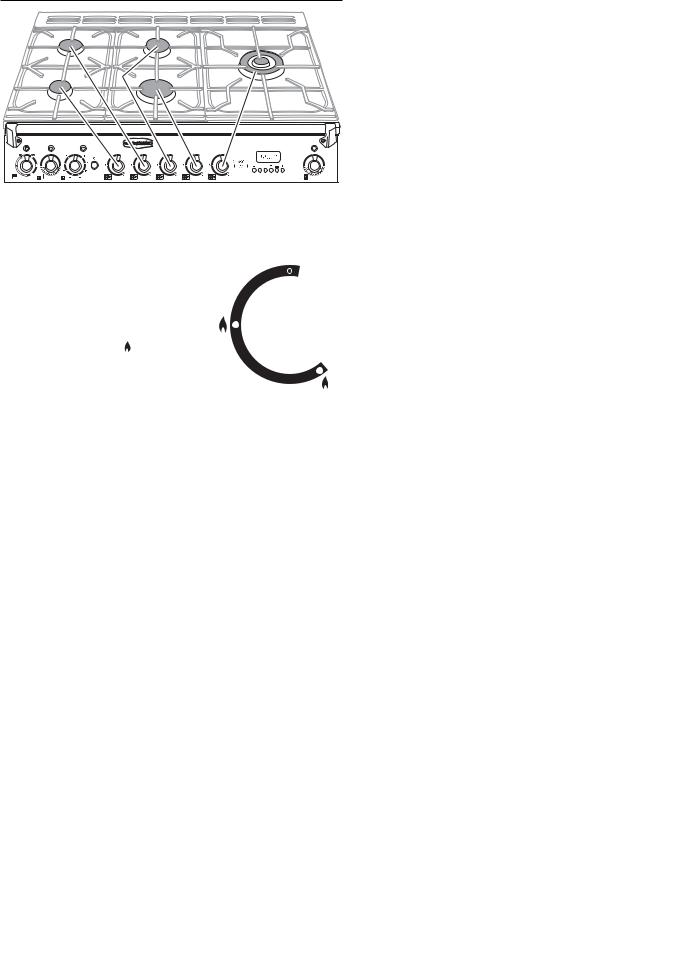
Hotplate Burners
Gas burners
The drawing by each knob indicates which burner that knob controls.
There is a spark ignition system that works when the knob is pressed in.
Push in and turn a knob to the solid flame symbol ( ). The igniter should spark and light the gas.
If a burner flame goes out, turn the control knob o and leave it for one minute before relighting it.
Adjust the flame height to suit by turning the knob.
On this cooker the low position is beyond high, not between high and o . The small flame marks the ‘low position’.
Turn the knob towards it after the contents of a pan have boiled
Make sure flames are under the pans. Using a lid will help the contents boil more quickly.
Pans and kettles with concave bases or down turned base rims should not be used.
Simmering aids, such as asbestos or mesh mats, are NOT recommended. They will reduce burner performance and could damage the pan supports.
Avoid using unstable and misshapen pans that may tilt easily and pans with a very small base diameter e.g. milk pans, single egg poachers.
The minimum pan diameter recommended is 120mm.
The maximum pan base diameter is 250mm.
The Wok burner is designed to provide even heat over a large area. It is ideal for large pans and stir frying. For heating smaller pans the smaller burners may be more e cient.
If a burner flame goes out, turn the control knob o and leave it for one minute before relighting it.
You can remove the burner parts for cleaning; see the ‘Cleaning your cooker’ section of the instructions.
You should wipe the enamel top surface of the cooker around the hotplate burners as soon as possible after spills occur. Try to wipe them o while the enamel is still warm.
Note:
Use of aluminium pans may cause metallic marking of the pan supports. This does not a ect the durability of the enamel and may be cleaned o with a metal cleaner such as 'Brasso'.
4
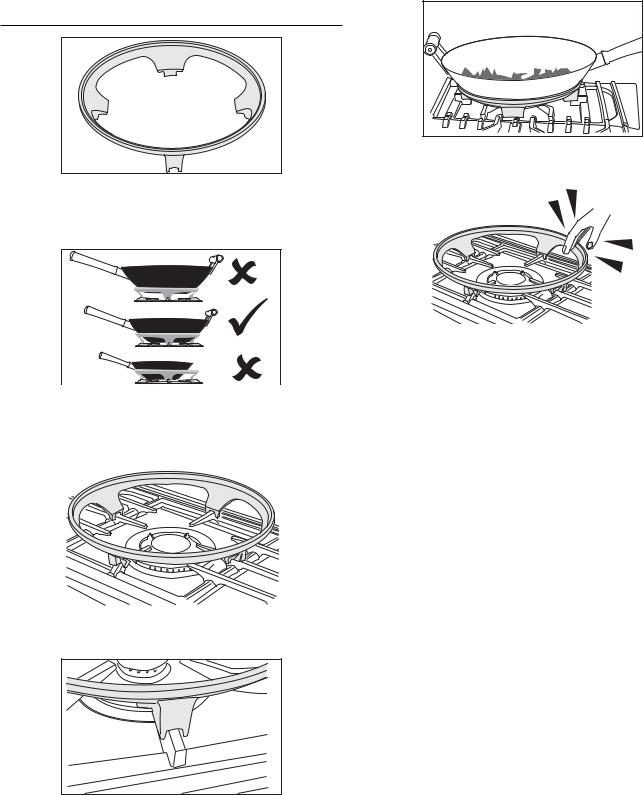
The Wok cradle
The Wok cradle is designed to fit a Typhoon™ Professional 35cm Wok (Part Code 13840S)
This is available from leading retailers.
If you use a di erent Wok make sure that it fits the cradle. Woks vary very widely in size and shape. It’s important that the Wok sits down on the pan support - but if the Wok is too small the cradle will not support it properly.
The cradle should be used on the triple ring Wok burner only.
When you fit the cradle check that the Wok is properly located on the front and rear fingers and that it is supported properly on a pan support.
Make sure the cradle is stable and that the Wok is sitting level in the ring.
The cradle will get very hot in use - allow plenty of time for it to cool before you pick it up.
Care and Cleaning
Essential information
Never use paint solvents, washing soda, caustic cleaners, biological powders, bleach, chlorine based bleach cleaners, coarse abrasives or salt.
Recommended cleaning materials are hot soapy water, a moistened soap pad, cream cleaner or a nylon scourer.
5
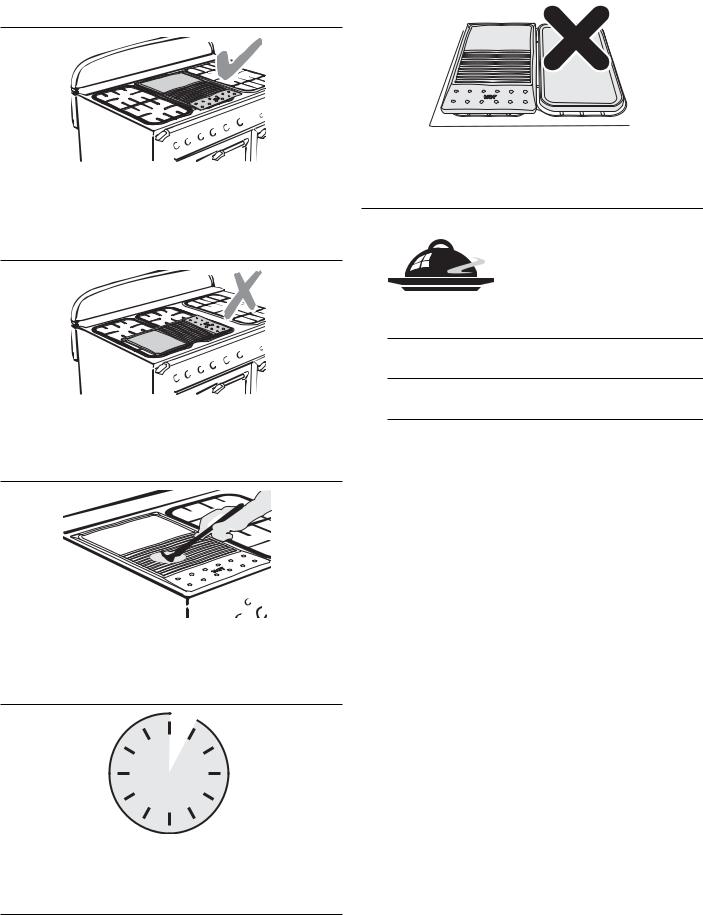
The Griddle
1
The griddle fits a single pan support, front to back. It is designed for cooking food on directly. Don’t use pans of any kind on it. The griddle surface is non-stick and metal cooking utensils (e.g. spatulas) will damage the surface. Use heat resistant plastic or wooden utensils.
2
Don’t put it crossways - it will not fit properly and will be unstable.
Don’t put it on the Wok burner - it is not designed to fit the Wok burner pan support.
3
Position the griddle over the hotplate burners resting on the pan support. The griddle can be lightly brushed with cooking oil before use. Light the hotplate burners. Adjust the flame heights to suit.
4
Preheat the griddle for a maximum of 5 minutes before adding food. Leaving it longer may cause damage. You can reduce the heat by turning the control knobs towards the lower position (marked with the small flame symbol).
5
Always leave space around the griddle for the gases to escape. Never fit two griddles side by side. Large pans should also be spaced well apart. The maximum pan base diameter is 250mm.
Use the following heat settings as a guide for griddle cooking.
High/medium:
Drop scones, Bacon, Chops, Steak, Burgers.
Medium/low:
Potato cakes, Eggs, Fish cakes.
Experience will soon familiarise you with the correct setting to use for cooking.
The griddle will get very hot in use - allow plenty of time for it to cool before you pick it up.
Use Only Dry Oven Gloves
Moist or damp gloves on hot surfaces may result in burns from steam. Never let oven gloves touch hot heating elements.
Do not use a towel or other bulky cloth in place of a glove. They might catch fire if they touch a hot surface.
Never operate the cooker with wet hands.
Clean after use with soapy water using a soft cloth, allow the griddle to cool before cleaning.
6
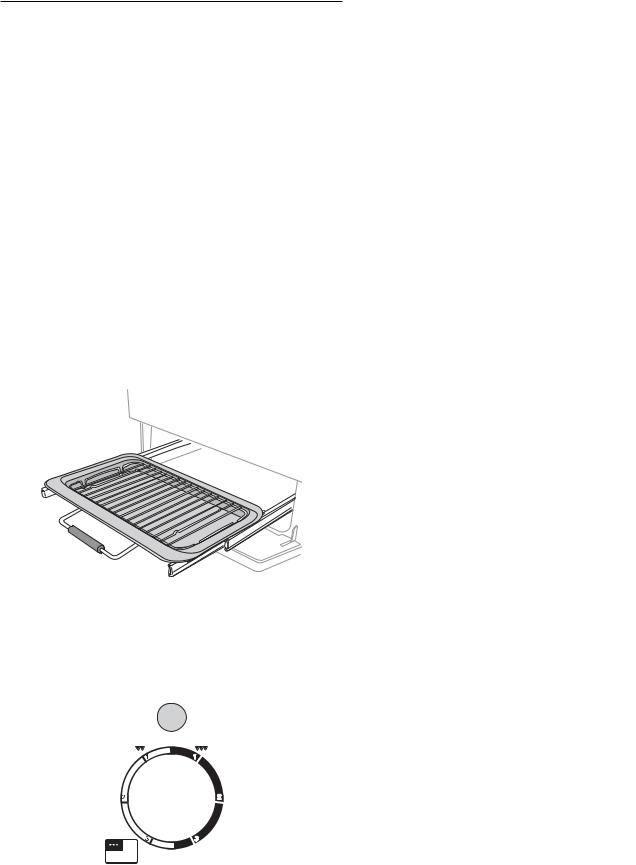
The Glide-out™ Grill
Caution: Accessible parts may be hot when the grill is in use. Young children should be kept away.
Before using the grill for the first time, make sure that all packing materials have been removed and then to dispel manufacturing odours, turn on the grill and run for 30 minutes with the grill pan in position, pushed fully back, and the grill door open.
Make sure the room is well ventilated to the outside air, by opening windows or turning on a cooker hood for example. We recommend that people with respiratory or allergy problems should vacate the area for this brief period.
Using the grill
Open the grill door and pull the grill pan carriage forward using the handle.
After placing your food on the grill grid, slide the grill carriage into the grill chamber. Make sure it is pushed right in.
The grill has two elements that allow either the whole area of the pan to be heated or just the right hand half. To heat the whole grill, turn the knob clockwise.
To heat the right hand half turn it anticlockwise.
The neon indicator light by the grill control will come on.
For best results preheat for 2 minutes with the grill pan in position. After placing your food on the grill pan grid,
slide in the grill carriage. Adjust the heat to suit by turning the knob.
Make sure the grill carriage is pushed right in.
Never close the grill door when the grill is on.
The grill pan grid can be turned over to give two grilling positions.
Don’t leave the grill on for more than a few moments, without the grill pan underneath it.
For best results, especially with toast, preheat the grill with the grill pan in the cooking position for two minutes before use.
The grill trivet can be removed and the food placed on it while you are waiting for the grill to preheat.
The grill pan and grill pan carriage can be easily removed for cleaning. See the ‘Cleaning your cooker’ section of these instructions.
When you pull the grill pan forward is the wide rim at the front? It's important that the wider part is at the front.
7

The Ovens
During use the appliance becomes hot. Care should be taken to avoid touching the heating elements inside the oven.
Before using for the first time, to dispel manufacturing odours turn the ovens to 230°C and run for an hour. To clear the smell, make sure the room is well ventilated to the outside air, by opening windows or turning on a cooker hood for example. We recommend that people with respiratory or allergy problems should vacate the area for this brief period.
The Left Hand Oven |
The Right Hand Tall Oven |
|||||
|
|
|
|
|
|
|
|
|
|
|
|
|
|
|
|
|
|
|
|
|
|
|
|
|
|
|
|
|
|
|
|
|
|
|
|
|
|
|
|
|
|
The left hand oven is a Multi-function oven. As well as |
The fan in the right hand Tall oven circulates hot air |
|
the oven fan and fan element, it is fitted with two extra |
continuously, which means faster more even cooking. |
|
heating elements, one visible in the top of the oven |
The recommended cooking temperatures for a fanned |
|
and the second under the oven base. Take care to avoid |
||
oven are generally lower than a non-fanned oven. |
||
touching the top element and element deflector when |
||
|
||
placing or removing items from the oven. For more detail |
|
|
on this oven see the section ‘Multi-function oven’. |
|
|
|
|
|
|
|
|
|
|
|
|
|
|
|
|
|
|
|
|
|
|
|
|
|
The Multi-function oven has two controls, a function |
The right hand fan oven control is on the right hand side |
||||||||||
selector and a temperature setting knob. |
of the control panel. |
||||||||||
Turn the function selector control to a cooking function.
Turn the oven temperature |
Turn the oven temperature |
knob to the temperature you |
knob to the temperature you |
need. |
need. |
|
|
|
|
|
The oven indicator light |
|
|
|
|
|
The oven indicator light |
|
|
|
|
|
will glow until the oven has |
|
|
|
|
|
will glow until the oven has |
|
|
|
|
|
reached the temperature you |
|
|
|
|
|
reached the temperature you |
|
|
|
|
|
selected. It will then cycle on |
|
|
|
|
|
selected. It will then cycle on |
|
|
|
|
|
and o during cooking |
|
|
|
|
|
and o during cooking. |
|
|
|
|
|
|
|
|
|
|
|
|
8
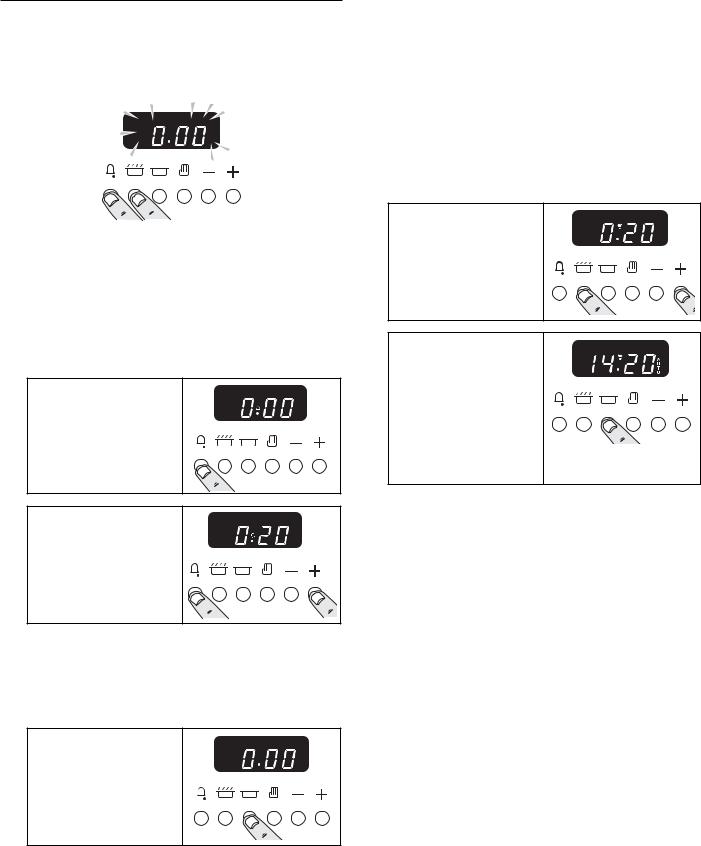
The Clock
You can use the timer to turn the left hand Multifunction Oven on and o . The clock must be set to the time of day before this oven will work.
To set the time of day
Press and hold as above. At the same time, press (-) or (+) until the correct time shows. Don’t forget it’s a 24-hour clock. If you make a mistake or press the
wrong button, turn o the power supply for a minute or two and start again.
To time something that’s cooking (minute minder)
Press and hold the
Minute Minder ( ).
).
At the same time press (-) or (+) until the time you want to cook for is shown.
You can check time remaining by pressing  and cancel the beeper when it is sounding by pressing
and cancel the beeper when it is sounding by pressing 
To stop automatically
Use when you have started the oven manually.
Press and hold the Stop
Time ( ) button.
) button.
At the same time press (-) or (+) until your required ‘Stop Time’ shows. AUTO will show in the display. When your cooking is finished the beeper sounds. TURN THE OVEN KNOB TO 0 FIRST, then press  once to stop the beep, press
once to stop the beep, press  again to return to manual cooking.
again to return to manual cooking.
To start and stop the oven automatically
Before you set the clock, you must have two numbers clearly in mind.
The ‘cook period’, which is the period of time you want the oven to cook.
The ‘stop time’, which is the time of day you want the oven to stop cooking.
You cannot set a start time directly - this is set automatically by setting the cooking period and stop time.
Press and hold the Cook Time ( ) button. At the same time press (-) or (+) until your required ‘cook period’ shows.
) button. At the same time press (-) or (+) until your required ‘cook period’ shows.
Press and hold the Stop
Time ( ) button.
) button.
At the same time press (-) or (+) until your required ‘stop time’ shows.
AUTO will show in the display.
Set the oven to the required temperature. When your cooking is finished the beeper sounds. TURN THE OVEN KNOB TO OFF FIRST, then press once to stop the beep, press
once to stop the beep, press again to return to manual cooking.
again to return to manual cooking.
If you are out, don’t worry about the beeper going o , it stops after a while. When you return, TURN THE OVEN KNOB TO OFF FIRST, then press twice, to return to manual cooking.
twice, to return to manual cooking.
AUTO is showing, you want to reset to manual cooking.
When cancelling an automatic setting, any cooking time already set must be returned to 0.00 before you can return to manual, by pressing the button.
button.
Clock Special Features
Key Lock
When the key lock is activated, the clock can be operated as usual but the oven is locked and will not come on. This means that your child could select a cook program but the program will not be activated and oven will not be switched on.
9

To activate the key lock
Make sure that the clock is in manual mode and cancel any active programs.
Hold the
Minute Minder ( ) and Cooktime (
) and Cooktime ( ) buttons for about 8 seconds.
) buttons for about 8 seconds.
‘On’ will appear on the display.
Press the ‘+’ button once.
The key symbol ( ) and ‘OF’ will appear on the display. Let go of the buttons.
The clock oven control functions are now locked.
After a few seconds the display will revert to show the time of day and the key symbol ( ).
To turn off the key lock
Hold the
Minute Minder ( ) and Cooktime (
) and Cooktime ( ) buttons for about 8 seconds.
) buttons for about 8 seconds.
‘OF’ will appear on the display.
Press the ‘+’ button once. The key symbol ( ) goes out and ‘On’ shows on the display. Let go of the buttons
After a few seconds the display will revert to show the time of day.
The oven and the clock oven control functions can now be used normally.
Cooking using the timer
The timer can control the left hand Multifunction oven only.
You can set the oven to turn on any time over the following 24-hour period
If you want to cook more than one dish, choose dishes that require approximately the same time. However, dishes can be ‘slowed down’ slightly by using small containers and covering them with aluminium foil, or ‘speeded up’ slightly by cooking smaller quantities or placing in larger containers.
Very perishable foods such as pork or fish should be avoided if a long delay period is planned, especially in hot weather.
Don’t place warm food in the oven. Don’t use an oven already warm. Don’t use if an adjoining oven is warm.
Avoid using wine or beer if there is a delay period, as fermentation may take place.
To avoid curdling, cream should be added to dishes just before serving.
Fresh vegetables, which may discolour during a delay period, should be coated in melted fat or immersed in a water and lemon juice solution.
Fruit pies, custard tarts or similar wet mixtures on top of uncooked pastry are only satisfactory if there is a short delay period. Dishes containing leftover cooked meat or poultry should not be cooked automatically if there is a delay period.
Whole poultry must be thoroughly defrosted before placing in the oven.
Check that meat and poultry are fully cooked before serving.
Both Ovens
Before using for the first time, to dispel manufacturing odours turn the ovens to 230°C and run for an hour. To clear the smell make sure the room is well ventilated to the outside air, by opening windows for example.
The wire shelves should always be pushed firmly to the back of the oven.
Baking trays meat tins etcetera should be placed level centrally on the oven’s wire shelves. Keep all trays and containers away from the sides of the oven, as overbrowning of the
food may occur.
For even browning, the maximum recommended size for a baking tray is 340mm by 340mm in the main oven.
Cooking high moisture content foods can create a ‘steam burst’, when the oven door is opened.
When opening the oven stand well back and allow any steam to disperse.
10
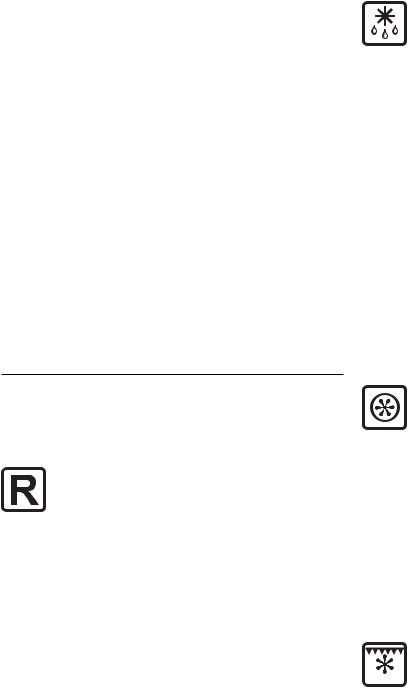
When the oven is on, don’t leave the door open for longer than necessary, otherwise the knobs may get very hot.
•Always leave a ‘fingers width’ between dishes on the same shelf. This allows the heat to circulate freely around them.
•The Cook & Clean oven liners (see Cleaning your cooker) work better when fat splashes are avoided. Cover meat when cooking.
•To reduce fat splashing when you add vegetables to hot fat around a roast, dry them thoroughly or brush lightly with cooking oil.
•If you want to brown the base of a pastry dish, preheat a baking tray for 15 minutes before placing the dish in the centre of the tray.
•Where dishes may boil and spill over during cooking, place them on a baking tray.
Multi-function oven functions
The Multi-function oven has many varied uses. We suggest you keep a careful eye on your cooking until you are familiar with each function. Remember - not all functions will be suitable for all food types.
Rapid Response
The Rapid Response setting enables you to pre-heat the oven faster than normal. It uses the fan oven element with additional heat from one of the elements in the top of the oven. Rangemaster fan ovens heat up quickly; but the Rapid Response feature speeds this process up enabling you to commence cooking sooner.
To use the Rapid Response feature, simply turn the function control knob to R and set the temperature you require. The light on the control panel adjacent to the R symbol will come on. When temperature is reached, the light will go out as will the element at the top of the oven. The fan element and oven fan will then continue to maintain your chosen oven temperature.
Should you choose to place food into the cold oven prior to cooking whilst using the Rapid Response function, ensure that cakes etc. are not positioned too near the top of the oven.
As with any cooking, particularly poultry, meat and ready meals, be sure the food is piping hot before serving.
Defrost
This function operates the fan to circulate cold air only. No heat is applied. This enables small items such as desserts, cream cakes and pieces of meat, fish and poultry to be defrosted.
Defrosting in this way speeds up the process and protects the food from flies. Pieces of meat, fish and poultry should be placed on a rack, over a tray to catch any drips. Be sure to wash the rack and tray after defrosting.
Defrost with the oven door closed.
Large items, such as whole chickens and joints should not be defrosted in this way. We recommend this be carried out in a refrigerator.
Defrosting should not be carried out in a warm oven or when an adjoining oven is in use or still warm.
Ensure that dairy foods, meat and poultry are completely defrosted before cooking.
Fan oven
This function operates the fan and the heating element around it. An even heat is produced throughout the oven, allowing you to cook large amounts quickly.
Fan oven cooking is particularly suitable for baking on several shelves at one time and is a good ‘allround’ function. It may be necessary to reduce the temperature by approximately 10°C for recipes previously cooked in a conventional oven.
If you wish to pre-heat the oven, wait until the indicator light has gone out before inserting the food.
Fanned grilling in the oven
This function operates the fan whilst the top element is on. It produces a more even, less fierce heat than a conventional grill. For best results, place the food to be grilled, on a grid over a roasting tin, which should be smaller than a conventional grill pan. This allows greater air circulation. Thick pieces of meat or fish are ideal for grilling in this way, as the circulated air reduces the fierceness of the heat from the grill. The oven door should be kept closed whilst grilling is in progress, so saving energy. You will also find that the food needs to be watched and turned less than for normal grilling. Pre-heat this function before cooking.
11
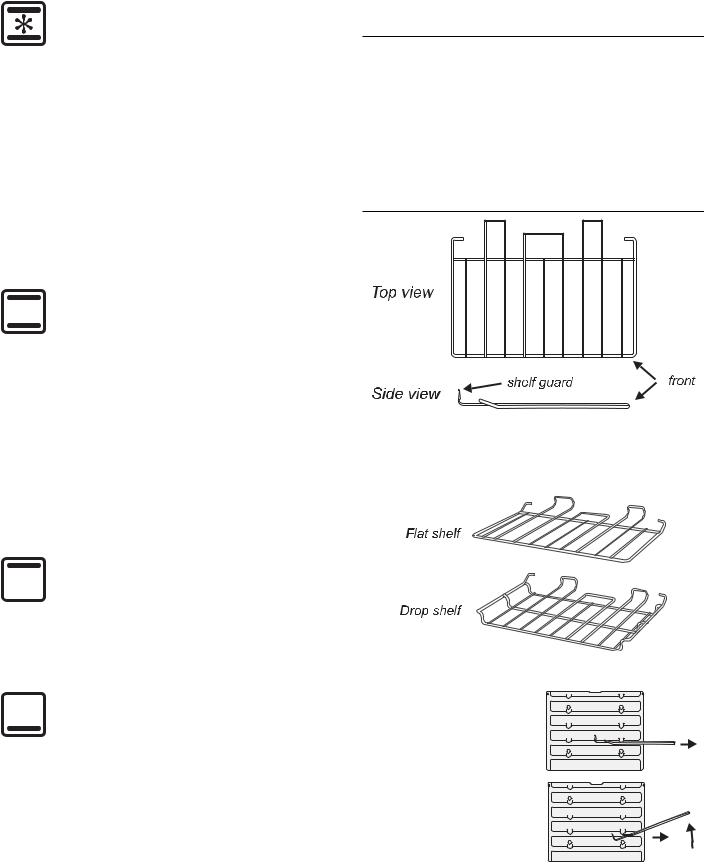
Fan assisted oven
This function operates the fan, circulating air heated by the elements at the top and the base of the oven. The combination of fan and conventional cooking (top and base heat) makes this function ideal for cooking large items that need thorough cooking, such as a large meat roast. It is also possible to bake on two shelves at one time, although they will need to be swapped over during the cooking time, as the heat at the top of the oven is greater than at the base, when using this function.
This is a fast intensive form of cooking; keep an eye on the food cooking until you have become accustomed to this function.
Conventional oven (top and base heat)
This function combines the heat from the top and base elements. It is particularly suitable for roasting and baking pastry, cakes and biscuits. Food cooked on the top shelf will brown and crisp faster than on the lower shelf, because the heat is greater at the top of the oven than at the base, as in ‘Fan assisted oven’ function. Similar items being cooked will need to be swapped around for even cooking. This means that foods requiring di erent temperatures can be cooked together, using the cooler zone in the lower half of the oven and hotter area to the top.
The Right Hand Oven
The fan in the right hand oven circulates hot air continuously, which means faster more even cooking.
The recommended cooking temperatures for a fanned oven are generally lower than a non-fanned oven.
The Main Oven shelve
the shelf guard should be at the back pointing upwards
As well as the flat shelves some models are supplied with a drop shelf. The drop shelf increases the possibilities for oven shelf spacing.
Browning element
This function uses the element in the top of the oven only. It is a useful function for the browning or finishing of pasta dishes, vegetables in sauce and lasagne, the item to be browned being already hot before switching to the top element.
Base heat
This function uses the base element only. It will crisp up your pizza or quiche base or finish o cooking the base of a pastry case on a lower shelf. It is also a gentle heat, good for slow cooking of casseroles in the middle of the oven or for plate warming.
The Browning and Base heat functions are useful additions to your oven, giving you flexibility to finish o items to perfection. With use, you will soon realise how these functions can combine to extend your cooking skills.
The oven shelves can be easily removed and refitted.
Pull the shelf forward until the back of the shelf is stopped by the shelf stop bumps in the oven sides.
Lift up the front of the shelf so the back of the shelf will pass under the shelf stop and then pull the shelf forward.
12
